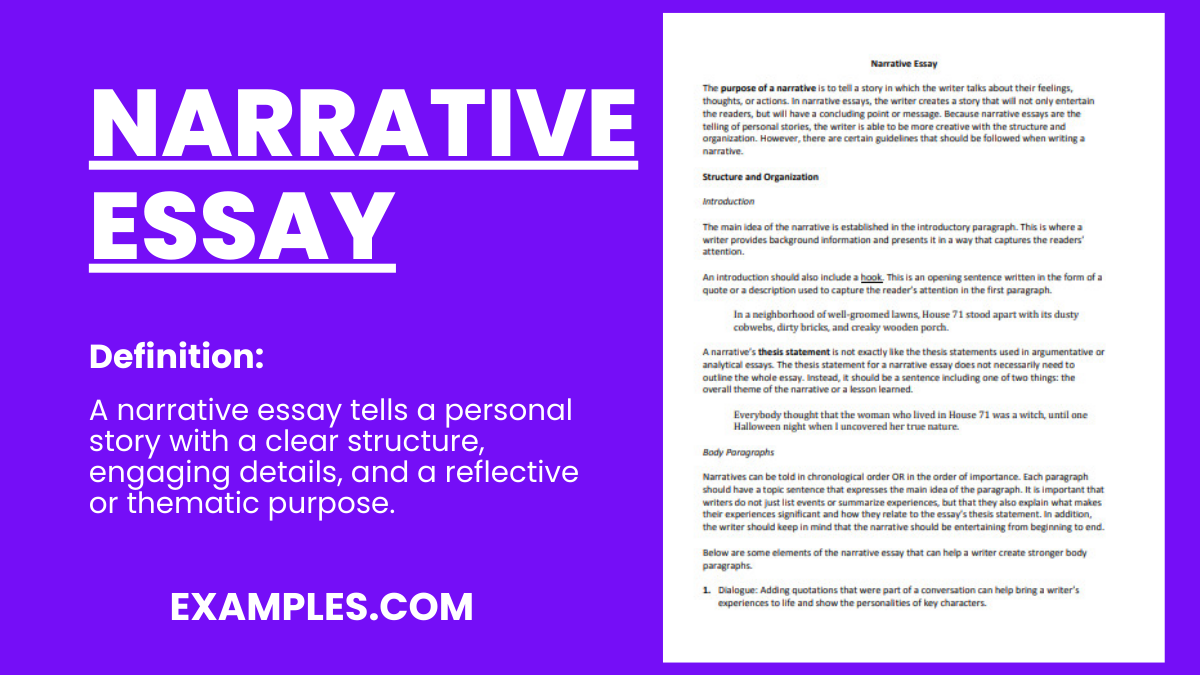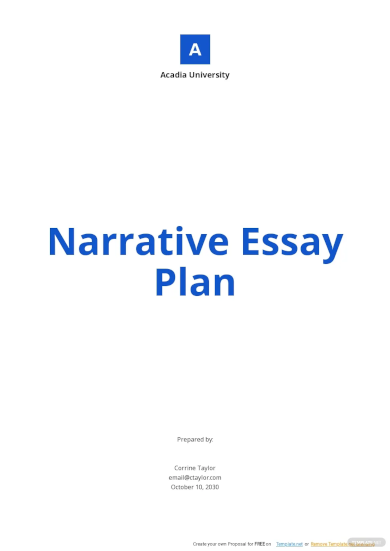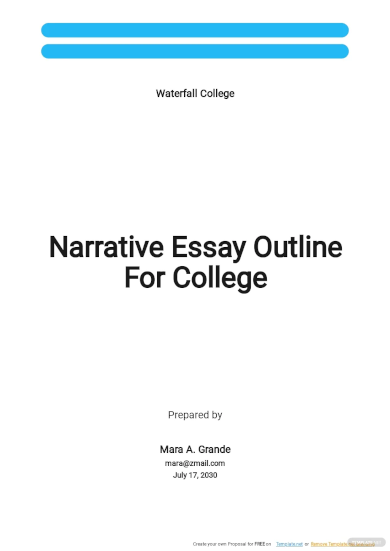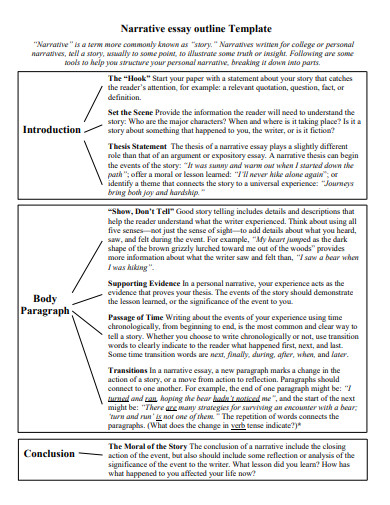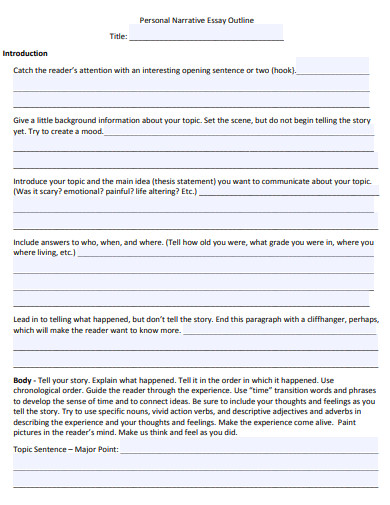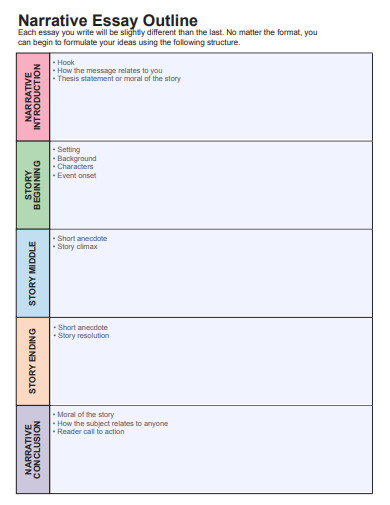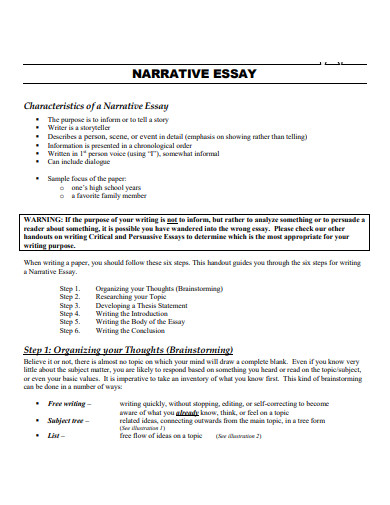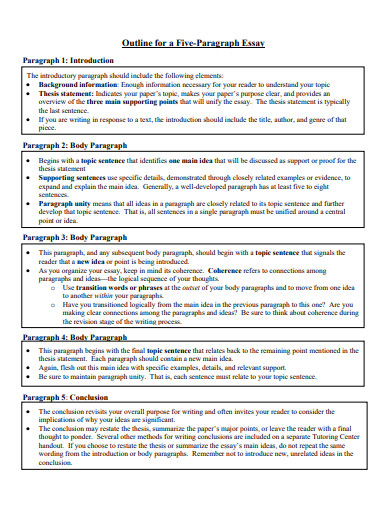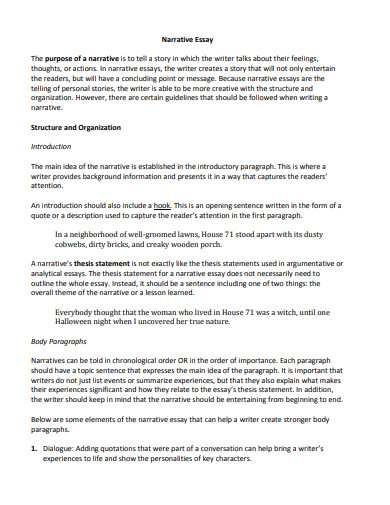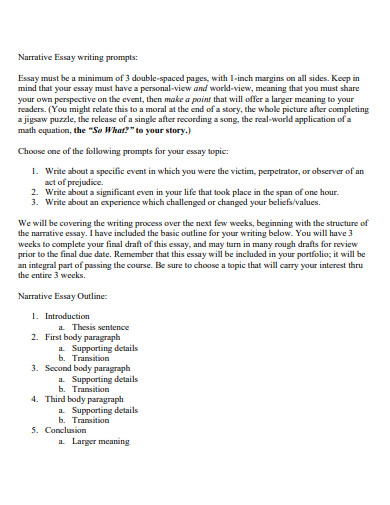8+ Narrative Essay Examples to Download
Most of us have written essays in school, where we had a formal theme book in which we wrote about our favorite literary works. Those were essential days. Essay writing continued to haunt us during high school and even college days. This is an excellent opportunity to improve our writing. We should never be frightened if we make common trial mistakes because we can develop learning and get excited about writing an essay next time. Institutions would generally let us write a narrative essay. So this boils down to the question, what is a narrative essay?
What is Narrative Essay?
A narrative essay is a type of writing that tells a story. Unlike other essays that argue points or analyze subjects, a narrative essay tells a personal story, much like a storyteller. The main goal of this essay is to entertain and engage the reader by recounting interesting events in a clear, coherent manner. It often reflects the writer’s personal experience, allowing them to express themselves creatively and compellingly. Narrative essays use vivid descriptions and a structured plot, including characters, a setting, a climax, and a conclusion, to bring the story to life.
The Best Example of Narrative Essay
Download this Narrative Essay in Word Download this Narrative Essay in PDFTitle: The Day I Became an Environmentalist
Introduction: One sunny afternoon, as I strolled through the lush, green park near my home, something extraordinary happened. It was a day that transformed my view of the world and carved a new path in my life.
Body: I had always considered myself nature-friendly, but I hadn’t really taken any concrete steps towards environmental conservation. That day, as I walked, I noticed a group of volunteers, young and old, diligently picking up litter, their hands shielded by gloves, their faces beaming with purpose.
Curious, I approached them, and they introduced me to their mission: a local environmental group dedicated to cleaning and preserving our community’s natural spaces. Intrigued, I decided to join in. As I picked up plastic bottles and discarded wrappers, a sense of responsibility began to burgeon within me.
The leader of the group, Mrs. Thompson, shared staggering facts about pollution and its impact on our planet. Her words struck a chord in me. We continued our work, and as the pile of collected trash grew, so did my resolve.
Climax: Then came the moment that sealed my commitment. We found a small bird, its leg trapped in a plastic ring, struggling helplessly. The group carefully freed the bird and tended to its injury. Watching the bird eventually fly away, a wave of emotion washed over me. It was a stark reminder of the impact our actions have on other living beings.
Conclusion: As the day ended, I realized that my casual stroll in the park had turned into a life-changing experience. I signed up as a regular volunteer and started making more environmentally conscious choices in my daily life. That day, I didn’t just help clean a park; I embarked on a journey as an environmentalist, committed to making a difference in the world.
This experience taught me the power of individual action in the fight against environmental degradation. It’s a lesson I carry with me every day, and through my narrative, I hope to inspire others to take their own steps towards protecting our planet.
Short Narrative Essay
Download this Narrative Essay in Word Download this Narrative Essay in PDFTitle: A Moment of Kindness
Introduction: On a brisk winter morning, I experienced a small act of kindness that left a lasting impact on my heart.
Body: I was running late for an important meeting, nerves frazzled, as I rushed towards the subway. In my haste, my bag snagged on a bench, spilling its contents. Papers fluttered like snowflakes in the wind. I felt a wave of panic, but then something wonderful happened.
A young girl, no more than eight, stopped and began gathering my papers. Her small hands worked quickly, a smile brightening her face. Others passed by, but she stayed, helping me collect every last sheet.
Her act of kindness in that chaotic moment was a beacon of calm. We exchanged no words, just a smile and a nod, a silent understanding of gratitude. As she handed me the last paper, her eyes sparkled with genuine warmth.
Conclusion: I made it to my meeting just in time, but the memory of the girl’s kindness stayed with me. It was a simple act, yet it reminded me of the profound impact kindness can have. In our busy lives, we often overlook these moments, but they hold the power to transform our day and touch our hearts.
Narrative Essay Format
A narrative essay tells a story, usually from the author’s perspective, and follows a clear and structured format. Understanding this format is crucial for effective storytelling in essay form.
Introduction
Hook: Begin with a compelling hook to grab the reader’s attention. This could be an intriguing statement, a question, or a brief preview of the story.
Setting the Scene: Provide background information that sets the stage for your story. This includes the setting, characters, and context.
Thesis Statement: Though not always necessary in narrative essays, a thesis can be used to present the main theme or lesson learned.
Body
Paragraphs: The body should be divided into several paragraphs, each focusing on a specific part of the story.
Chronological Order: Narratives typically follow a chronological order, but flashbacks or non-linear storytelling can be used effectively.
Character Development: Develop your characters through their actions, dialogue, and interactions within the story.
Vivid Descriptions: Use descriptive language to paint a picture for the reader, making the experience immersive.
Building the Plot: Ensure each paragraph contributes to the overall plot, leading towards a climax.
Climax
Turning Point: The climax is the most exciting part of the story, where the main conflict or challenge peaks.
Emotional Highpoint: This section should be emotionally engaging, capturing the essence of the conflict or experience.
Conclusion
Resolution: Wrap up the story by resolving the conflict or bringing the story to a close.
Reflection: Reflect on the events of the story and their impact. This could include lessons learned or how the experience changed the narrator.
Closing Remarks: End with final thoughts that leave a lasting impression on the reader.
Narrative Essay Outline
Creating an outline for a narrative essay helps in organizing thoughts and ensuring a coherent and engaging story. Here’s a basic outline to guide your writing:
Introduction
Hook: Start with an engaging opening to captivate your reader’s interest.
Setting: Briefly describe the time, place, and context of your story.
Characters: Introduce the main characters involved in your narrative.
Purpose: State the purpose or theme of your essay, if applicable.
Body
Paragraph 1:
Event 1: Describe the first key event or situation in your story.
Details: Add relevant details to create a vivid picture.
Character Reactions: Explain how the characters respond to Event 1.
Paragraph 2:
Event 2: Present the next significant event or development.
Details: Include descriptive details to enhance the narrative.
Character Reactions: Show how the characters react or change.
Paragraph 3 (and more, if needed):
Subsequent Events: Continue describing subsequent events, following the same pattern.
Build-up to Climax: Gradually build tension or suspense leading up to the climax.
Climax
Main Event: Present the climax or the most critical moment of your story.
Peak of Action: Highlight the peak of the action or conflict.
Character Responses: Focus on the characters’ responses and emotions.
Conclusion
Resolution: Describe how the conflict or action is resolved.
Reflection: Reflect on the events and their impact on the characters or yourself.
Lesson Learned: If applicable, discuss the moral or lesson learned from the story.
Closing Remarks: End with a statement that leaves a lasting impression on the reader.
Narrative Essay Topics with Samples
- Narrative Essay on Childhood Memories
- Narrative Essay on Road Accident I Witnessed
- Narrative Essay on How I spent my holiday
- Narrative Essay on On a Rainy Day
- Narrative Essay on The Day I never forget
- Narrative Essay on Friendship
- Narrative Essay on A Trip I never forget
- Narrative Essay on My First Day in School
- Narrative Essay on Personal Experience
- Narrative Essay on Overcoming a Challenge
- Narrative Essay on Losing a Loved One
- Narrative Essay on Earthquake
- Narrative Essay on Being Judged
Types of Narrative Essay
1. Personal Narrative Essay: A story from the writer’s own life or experiences, often highlighting a personal journey or lesson learned.
2. Descriptive Narrative Essay: Focuses on detailed, sensory descriptions to create a vivid picture of a scene, event, or character.
3. Historical Narrative Essay: Tells a story set in a historical context, blending factual history with storytelling elements.
4. Biographical Narrative Essay: Relays the life story of another person, emphasizing their experiences and achievements.
5. Fictional Narrative Essay: A made-up story created entirely from the writer’s imagination, not based on real events.
6. Adventure Narrative Essay: Focuses on an exciting or adventurous experience, often involving action and suspense.
7. Mystery Narrative Essay: Centers around a mystery or puzzle, engaging the reader in uncovering secrets or solving a problem.
8+ Narrative Essay Outline Examples
1. Narrative Essay Outline Template
2. Narrative Essay Outline For College Template
3. Narrative Essay Outline Template
4. Personal Narrative Essay Outline
5. Sample Narrative Essay Outline
6. Printable Narrative Essay Outline
7. Outline for a Five-Paragraph Essay Template
8. Narrative Essay Outline Format
9. Narrative Essay Outline in PDF
What purpose does a narrative essay serve?
Narrative writing allows writers to tell their stories uniquely. Also, it assists them in clarifying their thoughts and teaching them how to write them down in an organized manner. It also helps them in aiding in their quest for self-identity. They can learn about a variety of characters and settings through narrative writing.
How To Write a Narrative Essay?
Writing a narrative essay involves telling a story from your perspective and requires careful planning, detailed description, and a clear structure. Here’s a step-by-step guide to help you craft an effective narrative essay:
1. Choose Your Story:
- Select a meaningful event or experience from your life. It should be something you can write about in detail and has a clear beginning, middle, and end.
2. Create an Outline:
- Plan the structure of your essay. Outline the sequence of events and decide how you will introduce your story, build the plot, and conclude.
3. Write a Strong Introduction:
- Start with a hook to grab the reader’s attention. This could be a quote, a question, a vivid description, or an interesting fact.
- Set the scene by providing background information and context.
- Introduce the main characters involved in your story.
4. Develop the Body:
- Describe the events in chronological order, but feel free to use flashbacks or non-linear storytelling if it serves your narrative.
- Focus on making each paragraph a clear step in the progression of your story.
- Use descriptive language to paint a vivid picture for the reader.
- Show emotions and conflicts through dialogue and inner thoughts.
5. Build Up to the Climax:
- Lead the narrative towards the climax or the most critical point of your story.
- This is usually where the main conflict or tension reaches its peak.
6. Write a Satisfying Conclusion:
- Resolve the story and tie up any loose ends.
- Reflect on the events and share what you learned or how you changed as a result of the experience.
Tips to Write a Best Narrative Essay
- Choose a Meaningful Topic: Pick a story with personal significance or one that has impacted you deeply. This connection makes your narrative more authentic and engaging.
- Start with a Hook: Begin with a sentence that grabs the reader’s interest, like a thought-provoking question, a surprising fact, or a vivid description.
- Use Descriptive Language: Employ vivid, sensory details to create a rich, immersive experience for the reader. Describe sights, sounds, smells, and textures.
- Show, Don’t Tell: Instead of merely stating events, show them through action, dialogue, thoughts, and feelings to make your story more dynamic.
- Develop Characters and Setting: Give life to your characters with distinct personalities and voices. Set the scene with clear, descriptive details about the environment.
- Follow a Clear Structure: Organize your narrative with a clear beginning, middle, and end. Ensure your story flows logically and is easy to follow.
- Build to a Climax: Lead your story to a high point where the main conflict or tension reaches its peak. This keeps readers invested in the outcome.
FAQS
What does the term “narrative format” mean?
In writing, the narrative format is an effective structure for narrating stories and sharing anecdotes and messages. While the narrative format does not have to follow a strict chronological order or sequence of events effectively, all compelling narratives or stories should include five major components.
What is the definition of a simple narrative?
The events that makeup stories are referred to as a narrative. It’s the way events in a story or book are connected and form the plot. A narrative is a collection of related events told in a sequence of written or spoken words to the reader or listener.
What is the format of a narrative essay?
A narrative essay is an essay in which the entire narrative revolves around a single motif or central point. All of the events, happenings, and characters in the story revolve around a single theme. In terms of format, a narrative essay is similar to a simple five-paragraph article.
It should be enjoyable to write a narrative essay. It does not bind you to a strictly linear format with no room for creativity. That isn’t to say that breaking all the rules and writing something absurd is a good idea. If you’re still confused about what to write, consider your story as a coming-of-age story. An experience that shaped you into the person you are now. Your main goal is to take your readers on an adventure. Allow them to hear about your experience and learn something from it. The best stories are always those that take the audience outside of their usual comfort zones.


